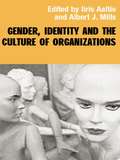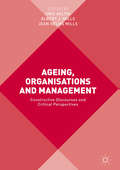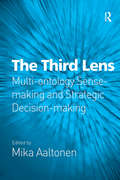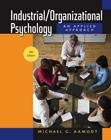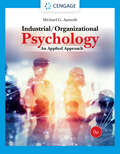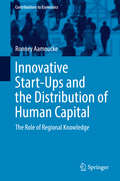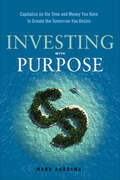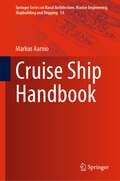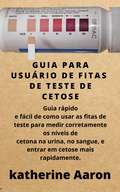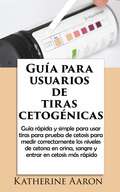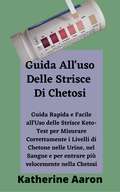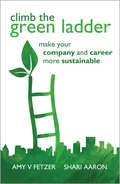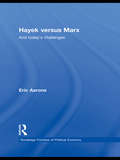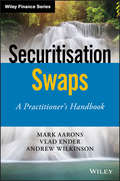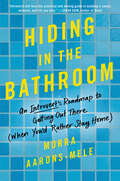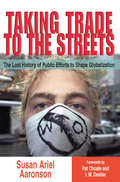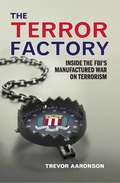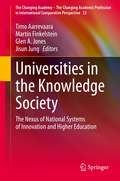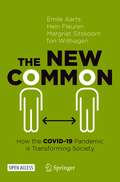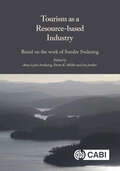- Table View
- List View
Gender, Identity and the Culture of Organizations (Routledge Studies in Management, Organizations and Society)
by Iiris Aaltio Albert J. MillsGender, Identity and the Culture of Organizations considers how organizations operate as spaces in which minds are gendered and men and women constructed. This edited collection brings together four powerful themes that have developed within the field of organizational analysis over the past two decades: organizational culture; the gendering of organizations; post-modernism and organizational analysis; and critical approaches to management. A range of essays by distinguished writers from countries including the UK, USA, Canada, Denmark, Sweden, Finland, the Netherlands and Sweden, explore innovative methods for the critical theorizing of organizational cultures.In particular, the book reflects the growing interest in the impact of organizational identity formation and its implications for individuals and organizational outcomes in terms of gender. The book also introduces research designs, methods and methodologies by which can be used to explore the complex interrelationships between gender, identity and the culture of organizations.
Ageing, Organisations and Management: Constructive Discourses and Critical Perspectives
by Iiris Aaltio Albert J. Mills Jean Helms MillsThis book explores critical perspectives on ageing in organisations and offers both managerial and workplace practices for dealing with this prominent issue. The collection provides cross-disciplinary research on the discursive and mythological aspects of ageing at work as well as recent studies of the relationship between age and innovation, talent, careers, and workplace transitions. The book brings together authors from Europe, North America and Australia. By addressing current societal challenges and offering insights on ageing at work, this book will be of interest to those involved in human resource management, workplace organisation and the sociology of work.
The Third Lens: Multi-ontology Sense-making and Strategic Decision-making
by Mika AaltonenAdvancing new sense-making tools for organizational strategy, this book demonstrates how to deal with asymmetric threats and opportunities. It employs participatory methods and multiple sector strategies to shift strategic thinking into considering disorder complexity and chaos. The contributors examine whether the 'third lens' or ontology of a project (its nature, work and strategic landscape) should influence the two other 'lenses' (our epistemological and methodological choices) that create an understanding of the world we live in. The book also considers the importance of time, in particular spatio-temporal relations that serve as reflection points for sense-making and strategic decision-making, both with respect to the situation in which they take place and as conceptual vehicles for managing multiple times and realities. Written for 21st century strategists, this volume will benefit people and organizations who struggle daily with multiple co-existing ontological, epistemological and methodological discourses.
Microsoft Dynamics AX 2012 Financial Management
by Mohamed AamerThis book is a practical, hands-on guide that covers both the basic and advanced concepts of financial management using Microsoft Dynamics AX.Microsoft Dynamics AX Financial Management is for Microsoft Dynamics AX solution architects, application consultants, support engineers, pre-technical sales consultants, and project managers on the partner side, as well as chief financial officers, financial controllers, accounting managers, key users, business analysts, and chief information officers on the customer side. A basic knowledge of financial terms, concepts, and Microsoft Dynamics AX terminologies will help you better understand the concepts covered in this book.
Industrial/Organizational Psychology: An Applied Approach (Sixth Edition)
by Michael G. AamodtStriking a balance between research, theory, and application, the sixth edition of INDUSTRIAL/ORGANIZATIONAL PSYCHOLOGY: AN APPLIED APPROACH prepares readers for their future careers through a combination of scholarship, humor, case studies, and practical applications. Readers will see the relevance of industrial/organizational psychology their everyday lives through such practical applications as how to write a resume, survive an employment interview, write a job description, create a performance appraisal instrument, and motivate employees. Charts and tables simplify such complicated issues as employment law, job satisfaction, work motivation and leadership.
Industrial/Organizational Psychology: An Applied Approach
by Michael G. AamodtStrike a balance between the latest research, proven theory and practical application as you demonstrate the relevance of industrial and organizational psychology to everyday life with Aamodt’s INDUSTRIAL/ORGANIZATIONAL PSYCHOLOGY: AN APPLIED APPROACH, 9E. <p><p>A wealth of updated applications work within an engaging narrative that guides students in analyzing topics such as interview survival, creating job descriptions, performance appraisal, changes in today's employment law, job satisfaction, work motivation and leadership. Students review timely topics such as gamifaction and the virtual workplace. Using a reader-friendly writing style, the author integrates humor, engaging and updated case studies and real examples from business today to make concepts both understandable and relevant for your students. The latest innovative charts, tables and flowcharts work with revised exercises prepare students to conceptualize complex issues.
Innovative Start-Ups and the Distribution of Human Capital
by Ronney AamouckeThis book contributes to our understanding of the reasons for the uneven geographic emergence and distribution of innovative start-ups and human capital, analyzing the role of the regional knowledge base and specifically academic knowledge. Using extensive datasets from West German regions and advanced econometric tools, it confirms a strong relationship between the presence of higher education institutions and the emergence of innovative start-ups. It also shows that the influence increases in direct relation with the innovativeness of the respective start-up, and that certain fields of knowledge are more influential than others in fostering innovative start-ups. In a second step, the multidimensional concept of quality of life is used to explain the geography of human capital across West German regions. Based on these empirical findings, the book shares valuable insights for higher education and regional development policy.
Investing with Purpose: Capitalize on the Time and Money You Have to Create the Tomorrow You Desire
by Mark AardsmaWhen he was 24 years old, Mark Aardsma was fired in a downsizing. He had little in the way of savings. But instead of panicking and seeking to land a new job immediately, he sat down and began to invest his time and money differently. By the time he was 34, he had multiplied his limited savings a thousand fold and controlled a multi-million-dollar portfolio of businesses and other investments.The notes he took as he made his idiosyncratic journey have now been expanded into a detailed guidebook for anyone aspiring to a bigger and better future. In Investing with Purpose, you will learn how to:Use all your resources to build your future, especially your precious, limited time.Avoid the emotional pitfalls that lead smart investors to make bad decisions.Face your fear and take reasonable risks to capitalize on your best opportunities.Apply your unique investment advantages—the only reliable path to superior results.Investing with Purpose will inspire you to use what you have to create the future you want. Whether your goal is to get rich, protect the rainforest, or just improve the neighborhood, this book will help you get there.
Cruise Ship Handbook (Springer Series on Naval Architecture, Marine Engineering, Shipbuilding and Shipping #14)
by Markus AarnioThis book offers a concise, yet comprehensive introduction to the engineering and other principles behind passenger cruise ships. It covers all the important regulations concerning cruise ship design and operation, as well as safety, stability, and environmental aspects. It describes principles of cruise ship hydrodynamics, structures, power plant and propulsion, as well as relevant machinery and control system. Further, it deals with key cruise ship hotel systems, such as air conditioning, freshwater, firefighting, garbage, wastewater and communication systems, and many more. Written in a concise, straightforward style, and including many original drawings, this book offers a unique, informative and inspiring guide, to students and professionals in the field of naval architecture and marine engineering, cruise ship owners and managers, and curious cruise ship passengers alike.
Guia Para Usuário De Fitas De Teste De Cetose
by Katherine AaronGuia rápido e fácil de como usar as fitas de teste para medir corretamente os níveis de cetona na urina, no sangue, e entrar em cetose mais rapidamente.
Guía para usuarios de tiras cetogénicas: Guía rápida para usar tiras cetogénicas, medir niveles de cetona y entrar en cetosis más rápido
by Katherine Aaron¡La guía completa sobre cómo medir los niveles de cetonas en la orina, la sangre y cómo entrar en cetosis más rápido! ¿No está muy seguro si se encuentra en cetosis? ¿Pero tiene fatiga, sed, gripe y mal aliento? ¡Ha seguido una dieta cetogénica durante algunos días! ¿Está buscando una guía completa sobre cómo usar las tiras de prueba de cetosis y las formas de entrar en cetosis más rápido en 48 horas? Si esto es lo que estás experimentando, ¡siga leyendo! Las tiras cetogénicas o las tiras de prueba de cetona son papeles distintivos finamente cortados en los que orina o deja caer sangre y cambiará de color en caso de orina y proporcionará datos en caso de sangre para mostrar los niveles de cetona en el sistema. Estas tiras no solo verifican las cetonas en el cuerpo, sino que también nos ayudarán a informarnos cuando estamos obteniendo demasiadas cetonas que pueden conducir a cetoacidosis (una afección en la que la sangre se vuelve ácida). Estas tiras fueron creadas inicialmente para controlar afecciones médicas como diabetes tipo II, cáncer y epilepsia. Todas estas condiciones pueden ser controladas si las cetonas en el cuerpo están bien mantenidas. Esta guía “GUÍA DEL USUARIO DE TIRAS DE CETOSIS: Guía rápida y fácil de usar tiras de prueba de ceto para medir correctamente los niveles de cetonas en orina, sangre y entrar en cetosis más rápido” brindará información sobre lo siguiente: Cómo entrar en cetosis Entrar en cetosis ¿Por qué la necesidad de cetosis? Afirmar que se encuentra en cetosis Cómo lidiar con los síntomas incómodos causados por la cetosis Cómo entrar en cetosis más rápido Como medir cetonas Cómo funcionan las tiras cetogénicas Tipos de tiras de cetogénicas ¿Son precisas las tiras cetogénicas? Cómo funcionan las tiras de análisis de cetona en sangre<br
Guida All'uso Delle Strisce Di Chetosi
by Katherine AaronLa Guida completa su come misurare i livelli di chetoni nelle urine, nel sangue e come entrare più velocemente nella chetosi! Non siete troppo sicuri di essere in chetosi? Ma avete affaticamento, sete, influenza e boccaccia? Avete fatto una dieta chetogena per alcuni giorni! Siete alla ricerca di una guida completa su come usare le strisce reattive per la chetosi e su come entrare più velocemente nella chetosi entro 48 ore? Se questo è ciò che state sperimentando, continuate a leggere! Le strisce reattive per chetogeni o le strisce reattive per chetoni sono foglietti distintivi tagliati sottili su cui si fa pipì o su cui si fa cadere il sangue e che cambiano colore in caso di urina e forniscono dati in caso di sangue per mostrare i livelli di chetoni nel sistema. Queste strisce non solo controlleranno i chetoni nell'organismo, ma ci aiuteranno anche a capire quando abbiamo troppi chetoni che possono portare alla chetoacidosi (una condizione in cui il sangue diventa acido). Queste strisce sono state inizialmente create per gestire condizioni mediche come il diabete di tipo II, il cancro e l'epilessia. Tutte queste condizioni possono essere regolate se i chetoni nel corpo sono ben mantenuti. Questa guida "GUIDA PER L'USO DELLE STRISCE KETO: Guida rapida e facile all'uso delle strisce per misurare correttamente i livelli di chetoni nelle urine, nel sangue e per entrare più velocemente nella chetosi" farà luce su quanto segue: Come entrare in chetosi Entrare in chetosi Perché la necessità della chetosi Segnatevi che siete in chetosi Come gestire i sintomi scomodi dovuti alla chetosi Come entrare più velocemente nella chetosi Come misurare i chetoni Come funzionano le strisce di keto Tipi di strisce di chetosi Le strisce di keto sono precise? Come funzionano le strisce per il test del chetone Tempo di us
New England Patriots: Making the Team
by Aaron M.G. Zimmerman Nancy Dean BeaulieuExamines the organizational strategy of a professional football team that contributed to the team's sustained success. Considers several aspects of the team's "blueprint" with respect to players: recruitment, retention, task structure, training, culture, and compensation. Presents opportunities to explore: the potential complementarities between multiple human resources systems, the role of intrinsic motivation and extrinsic incentives, whether star players are incompatible with well-functioning teams, and the establishment and maintenance of a culture that reinforces goal alignment.
Saving Disney
by Aaron M.G. Zimmerman Nancy Dean BeaulieuAt a March 2004 annual shareholder meeting, 45% of Walt Disney Co.'s shareholders withheld their support from CEO and Chairman Michael Eisner, producing a large no-confidence vote in the company's leader. The company had struggled financially in recent years and the board was widely believed to be beholden to Eisner. Two directors, Roy Disney and Stan Gold, resigned in protest of Eisner's leadership and the board's unwillingness to change. The two began to wage a PR battle calling for Eisner's removal and asking all shareholders to withhold their support from him at the upcoming shareholder meeting. Traces the history of Eisner's reign at the company and the events leading up to the March 3, 2004, shareholders meeting.
Performance Pay for MGOA Physicians (A)
by Aaron M.G. Zimmerman Kevin J. Bozic Jason R. BarroExamines the transition of an orthopedic surgical group at a premier teaching and research hospital from a system in which the surgeons are compensated with flat salaries to a system where they are compensated based on profitability. Allows for an examination of several critical issues in incentive strategy, including pay-to-performance in a not-for-profit environment, whether a compensation system is truly aligned with value creation (issues of quality of care and research time), and the difficulty in designing a compensation system in a competitive labor market when the objectives of the institution extend beyond pure profit maximization. This is a rewritten version of an earlier case.
Sales Force Training at Arrow Electronics (A)
by Aaron M.G. Zimmerman Brian J. Hall Jason R. BarroIn the mid-1980s, Arrow, the world's largest electronics distributor, implemented a college recruiting program to hire salespeople. The program was part of an effort to increase the professionalism and skill set of the sales force in an industry where few salespeople had college degrees. After an expensive and thorough training program, many of the new college grads hired were poached by Arrow's competitors for higher salaries. Arrow was ultimately unsuccessful in persuading the college grads to stay, and the recruiting program ended after five years. In 1997, CEO Steve Kaufman decided to start a new college recruiting program, determined not to repeat the mistakes of the past. A rewritten version of an earlier case.
Climb the Green Ladder
by Shari Aaron Amy V. FetzerWant to make your workplace more sustainable, get ahead in your career and improve your reputation?Want to help your company or organisation save money, boost profits and improve its brand?Whatever your level or industry, from sales and management to government and teaching, Climb The Green Ladder offers practical knowledge to help you make a difference. Whether you'd like to transform your entire company or just get your colleagues recycling, Climb The Green Ladder will provide you with the tools and motivation to move your company (and career) towards a more successful, more sustainable future. The twin challenges of the economic meltdown and climate change means we must act quickly to evolve our businesses to weather the storm. You can ensure your company or organisation saves money, reduces environmental damage and improves its performance while you advance your personal reputation and further your career.Step by step, Climb The Green Ladder identifies the key themes that underpin successful sustainability strategies, including real-life case studies from people who've done it, to create a comprehensive tool-kit for action. Authors Amy Fetzer and Shari Aaron undertook extensive research to find out what works and what doesn't. They surveyed hundreds of employees and employers, and interviewed over 80 sustainability specialists who have successfully changed their workplaces from within to reveal the secrets of their success.
Hayek Versus Marx: And today's challenges (Routledge Frontiers of Political Economy)
by Eric AaronsThe aim of the book is to stimulate the realignment of political, theoretical and philosophical thinking that is now beginning in response to global warming. The author provides an examination of the theories of the most prominent social philosophers of the 19th and 20th centuries – Karl Marx and Friedrich Hayek. He does so in the belief that the work of these two thinkers, in their commonalities and differences, successes and failures, contain important indicators of the content of a social philosophy suited to today’s conditions. The book proceeds in the context of the failure of the attempts by followers of Marx, having achieved political power, to realise the objectives they took to issue from his theories, on the one hand, and of the earlier successes, but now emerging failures of the neo-liberal philosophy of Hayek to cope with the with the environmental outcomes of those very successes, on the other. In doing so, the book will incidentally critique postmodernism, because of its claim to be ‘Theory’ as such, which for a generation impeded genuine theoretical and philosophical work.
Securitisation Swaps: A Practitioner's Handbook (Wiley Finance)
by Mark Aarons Vlad Ender Andrew WilkinsonDevelop the skillset essential to successful securitisation swaps management Securitisation Swaps is a complete practitioner’s guide to this unique and complex class of derivatives. This detailed examination follows the entire life cycle of securitisation swaps to give quants, structurers, traders, originators, issuers and lawyers a common reference for understanding their shared objective. Broad in scope to provide a common-ground perspective — yet detailed enough to promote full understanding — the discussion takes a distinctly cross-disciplinary approach that encompasses the multi-faceted knowledge base required to successfully execute these complex trades. Despite the fact that the size of the market is trillions of dollars in notional principal, securitisation swaps have thus far been neglected in both academic and practitioner literature. The numerous stakeholders that work together on these complex deals will all greatly benefit from a thorough understanding of their underlying risks and gain deep insight into the perspectives of each stakeholder. This invaluable guide provides multi-disciplinary insight that allows practitioners to: Manage securitisation swaps more effectively, from pre-trade structuring and modelling to post-trade risk management and accounting Understand the elements of securitisation and covered bonds, and how swaps mitigate risk in these types of transactions Explore how securitisation swaps differ from other derivatives and delve into their three specific risk factors — swap prepayment risk, swap extension risk and downgrade risk Learn practical methods and strategies of risk management, accounting, pricing and transaction execution When securitisation trades go wrong, they become front-page news — but when each participant understands accurate modelling, risk mitigation, optimal structuring, costs, pricing, commercial backgrounds and other integral practices, they are able to work together to achieve a shared objective. Securitisation Swaps provides the essential knowledge that streamlines and safeguards these important trades.
Hiding in the Bathroom: An Introvert's Roadmap to Getting Out There (When You'd Rather Stay Home)
by Morra Aarons-Mele“Introverts will love this practical and moving guide to building a career, network, and life you love.” - Susan Cain, author of Quiet From the marketing guru and host of the popular podcast Hiding in the Bathroom, a breakthrough introverts' guide that broadens the conversation sparked by Quiet and moves away from the "Lean In" approach, offering wisdom and practical tips to help readers build strong relationships and achieve their own definition of professional success.Most ambitious people believe that reaching the peaks of success means being on 24/7—tirelessly networking, deal-making, and keynoting conferences. This is nonsense, says Morra Aarons-Mele. As an eminent entrepreneur with a flourishing business and a self-proclaimed introvert with lots of anxieties, Morra disagrees with the notion that there’s only one successful "type": the intense, super social, sleep-deprived mover and shaker, the person who musters endless amounts of "grit." Hiding in the Bathroom is her antidote for everyone who is fed up with feeling like they must always "lean in"—who prefer those moments of hiding in the bathroom to constantly climbing the ladder or working the room.Morra knows what it takes to make your mark, and now, this entrepreneur who has boosted the online strategy of clients such as the Malala Fund, President Obama, the UN Foundation, and the Bill and Melinda Gates Foundation shares the insights, tricks, and knowledge she’s learned. Filled with advice, exercises to help readers evaluate their own work/life fit and manage anxiety, valuable tools, and stories of countless successful people—entrepreneurs, academics, and novices just beginning their careers—Hiding in the Bathroom empowers professionals of all ages and levels to take control and build their own versions of success. Thoughtful and practical, it is a must-have handbook for building a fantastic, prosperous career and a balanced, happy life—on your own terms.
Taking Trade to the Streets: The Lost History of Public Efforts to Shape Globalization
by Susan Ariel AaronsonIn the wake of civil protest in Seattle during the 1999 World Trade Organization meeting, many issues raised by globalization and increasingly free trade have been in the forefront of the news. But these issues are not necessarily new. Taking Trade to the Streetsdescribes how so many individuals and nongovernmental organizations came over time to see trade agreements as threatening national systems of social and environmental regulations. Using the United States as a case study, Susan Ariel Aaronson examines the history of trade agreement critics, focusing particular attention on NAFTA (the North American Free Trade Agreement between Canada, Mexico, and the United States) and the Tokyo and Uruguay Rounds of trade liberalization under the GATT. She also considers the question of whether such trade agreement critics are truly protectionist. The book explores how trade agreement critics built a fluid global movement to redefine thetermsof trade agreements (the international system of rules governing trade) and to redefine how citizens talk about trade. (The "terms of trade" is a relationship between the prices of exports and of imports. ) That movement, which has been growing since the 1980s, transcends borders as well as longstanding views about the role of government in the economy. While many trade agreement critics on the left say they want government policies to make markets more equitable, they find themselves allied with activists on the right who want to reduce the role of government in the economy. Aaronson highlights three hot-button social issues--food safety, the environment, and labor standards--to illustrate how conflicts arise between trade and other types of regulation. And finally she calls for a careful evaluation of the terms of trade from which an honest debate over regulating the global economy might emerge. Ultimately, this book links the history of trade policy to the history of social regulation. It is a social, political, and economic history that will be of interest to policymakers and students of history, economics, political science, government, trade, sociology, and international affairs. Susan Ariel Aaronson is Senior Fellow at the National Policy Institute and occasional commentator on National Public Radio's "Morning Edition. "
The Terror Factory
by Trevor AaronsonA groundbreaking work of investigative journalism, The Terror Factory: Inside the FBI's Manufactured War on Terrorism exposes how the FBI has, under the guise of engaging in counterterrorism since 9/11, built a network of more than fifteen thousand informants whose primary purpose is to infiltrate Muslim communities to create and facilitate phony terrorist plots so that the Bureau can then claim it is winning the war on terror. The paperback edition of The Terror Factory includes all new information on the FBI's counterterrorism efforts related to the 2013 Boston Marathon bombing, as well as how the government has used (potentially illegally) FISA information in sting cases.Trevor Aaronson is an investigative reporter for Al Jazeera America. He has won more than two dozen national and regional awards, including the Molly Prize, the international Data Journalism Award, and the John Jay College/Harry Frank Guggenheim Excellence in Criminal Justice Reporting Award.m organization-including the story of an accused murderer who became one of the FBI's most prolific terrorism informants-and how so-called terrorism consultants and experts have made fortunes by exaggerating the threat of Islamic terrorism in the United States.Trevor Aaronson is associate director and co-founder of the Florida Center for Investigative Reporting, a nonprofit journalism organization that produces reporting about Florida and Latin America. He was a 2010-11 investigative reporting fellow at the University of California, Berkeley, where his reporting about the FBI's informants in US Muslim communities resulted in a Mother Jones cover story that won the John Jay College/Harry Frank Guggenheim 2012 Excellence in Criminal Justice Reporting Award.
Universities in the Knowledge Society: The Nexus of National Systems of Innovation and Higher Education (The Changing Academy – The Changing Academic Profession in International Comparative Perspective #22)
by Timo Aarrevaara Martin Finkelstein Jisun Jung Glen A. JonesThis book explores the complex, multi-faceted relationships between national research and innovation systems and higher education. The transition towards knowledge societies/economies is repositioning the role of the university and transforming the academic profession. The volume provides a foundational introduction to the concepts of knowledge society and knowledge economy, and these concepts ground the detailed case studies of eighteen systems, located across five continents. Each case study was written by a leading expert in that jurisdiction, and provides a critical analysis of the research and development infrastructure, the role of universities, and the implications for the academic profession. The book describes how nations in various geographic regions and at various stages of economic maturity are restructuring their university systems to adapt to the new imperatives, and provides a cross-case analysis identifying common themes and distinctive features. In telling the story of higher education’s on-going global metamorphosis, the contributing authors place current developments in the context of the university’s historic evolution, survey the changing metrics that national governments are adopting to measure university performance, and describe a new international project, the Academic Profession in the Knowledge-based Society [APiKS] that involved a common survey of academics in more than twenty countries to take the pulse of developments “on the ground” while documenting the challenges confronting knowledge workers in the new economy.
The New Common: How the COVID-19 Pandemic is Transforming Society
by Emile Aarts Hein Fleuren Margriet Sitskoorn Ton WilthagenThis open access book presents the scientific views of some fifty experts on how they believe the COVID-19 pandemic is currently affecting society, and how it will continue to do so in the years to come. Using the concept of a “common” (in the sense of common values, common places, common goods, and common sense), they elaborate on the transition from an Old Common to a New Common. In carefully crafted chapters, the authors address expected shifts in major fields like health, education, finance, business, work, and citizenship, applying concepts from law, psychology, economics, sociology, religious studies, and computer science to do so. Many of the authors anticipate an acceleration of the digital transformation in the forthcoming years, but at the same time, they argue that a successful shift to a new common can only be achieved by re-evaluating life on our planet, strengthening resilience at an individual level, and assuming more responsibility at a societal level.
Tourism as a Resource-based Industry: Based on the Work of Sondre Svalastog
by Øystein Aas Lars Aronsson Sjur Baardsen Børge Dahle Marko Košcak Brian McNeil Stian Stensland Sondre Svalastog Anthony TravisTourism as a Resource-based Industry presents the conceptual framework of the Norwegian economic geographer Sondre Svalastog and functions as a practical tool for analyzing and identifying resources when working towards a more sustainable tourism industry. Tourism resources and their sustainability are analysed through the lens of a multidisciplinary approach which includes social, economic, cultural and natural dimensions. Contextual awareness is achieved by combining research-based knowledge with local know-how and information on local conditions. The book facilitates a way forward that examines both productivity and sustainability. The usefulness and value of Svalastog's conceptual work is demonstrated by a selection of new case studies by experts in the field, from different countries including Sweden, Norway, Slovenia, and the UK. This book: - Identifies local conditions and resources, climate change concerns, different types of tourists and a variety of challenges in high-cost and low-cost countries. - Considers how best to maximise potential and production, ensuring that both the host community and tourist benefits. - Provides a wide-ranging selection of case studies covering topics such as urban heritage, national parks, niche tourism and location-specific tourism products. - Presents ideas on how to secure sound planning within the industry, using conceptual and methodological tools. Tourism researchers and students will find this book helpful for understanding the development of tourism and how it can contribute to the UN Agenda 2030 which reflects the urgency for change, to secure cultural and natural resources, health and social resilience, and the stability of a socially constructed economy. Thus, tourism research needs to include a constant review and if required, renewal of processes that manage how society, culture and natural resources are used to achieve a balanced sustainable tourism process.
